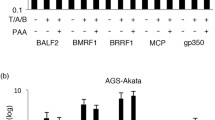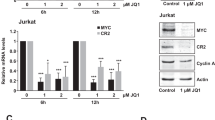Abstract
Epstein-Barr virus (EBV) is a ubiquitous human herpesvirus that transforms primary B lymphocytes, yielding lymphoblastoid cell lines (LCLs). EBV-encoded nuclear antigen 2 (EBNA2) and EBV-encoded nuclear antigen leader protein (EBNALP) are the first viral products expressed after EBV infection of primary B lymphocytes and are essential for EBV-induced B-lymphocyte growth transformation. EBNA2 functions as a transcriptional activator of viral and cellular genes, with EBNALP as a coactivator for EBNA2-mediated transcriptional activation. We previously reported that mutant EBNALP with a C-terminal 10-amino-acid truncation loses the ability to coactivate, and has a dominant-negative effect on wild-type-EBNALP-mediated coactivation. However, the functional relevance of EBNALP in maintenance of LCL cell growth has not been investigated. To address this, we have constructed LCL-derived cell clones in which this dominant-negative form of EBNALP (DNLP) is conditionally expressed by the Cre-loxP system. We used these cells to evaluate the effect of DNLP expression on EBV-induced cell proliferation. After drug treatment, the DNLP-expressing LCL clones showed reduced cell proliferation and viability. These results indicate that EBNALP is critical for maintaining LCL growth and EBV-induced cell proliferation.






Similar content being viewed by others
References
Longnecker R, Kieff E, Cohen J (2013) Epstein-Barr virus. In: Knipe D, Howley P (eds) Fields virology, vol 2, 6th edn. Lippincott Williams and Wilkins, Philadelphia, pp 1898–1959
Alfieri C, Birkenbach M, Kieff E (1991) Early events in Epstein-Barr virus infection of human B lymphocytes. Virology 181(2):595–608
Wang F, Tsang SF, Kurilla MG, Cohen JI, Kieff E (1990) Epstein-Barr virus nuclear antigen 2 transactivates latent membrane protein LMP1. J Virol 64(7):3407–3416
Wang F, Gregory C, Sample C, Rowe M, Liebowitz D, Murray R, Rickinson A, Kieff E (1990) Epstein-Barr virus latent membrane protein (LMP1) and nuclear proteins 2 and 3C are effectors of phenotypic changes in B lymphocytes: EBNA-2 and LMP1 cooperatively induce CD23. J Virol 64(5):2309–2318
Harada S, Kieff E (1997) Epstein-Barr virus nuclear protein LP stimulates EBNA-2 acidic domain-mediated transcriptional activation. J Virol 71(9):6611–6618
Sinclair AJ, Palmero I, Peters G, Farrell PJ (1994) EBNA-2 and EBNA-LP cooperate to cause G0 to G1 transition during immortalization of resting human B lymphocytes by Epstein-Barr virus. EMBO J 13(14):3321–3328
Mannick JB, Cohen JI, Birkenbach M, Marchini A, Kieff E (1991) The Epstein-Barr virus nuclear protein encoded by the leader of the EBNA RNAs is important in B-lymphocyte transformation. J Virol 65(12):6826–6837
Szymula A, Palermo RD, Bayoumy A, Groves IJ, Ba Abdullah M, Holder B, White RE (2018) Epstein-Barr virus nuclear antigen EBNA-LP is essential for transforming naive B cells, and facilitates recruitment of transcription factors to the viral genome. PLoS Pathog 14(2):e1006890. https://doi.org/10.1371/journal.ppat.1006890
Peng CW, Xue Y, Zhao B, Johannsen E, Kieff E, Harada S (2004) Direct interactions between Epstein-Barr virus leader protein LP and the EBNA2 acidic domain underlie coordinate transcriptional regulation. Proc Natl Acad Sci USA 101(4):1033–1038. https://doi.org/10.1073/pnas.0307808100
Kanegae Y, Lee G, Sato Y, Tanaka M, Nakai M, Sakaki T, Sugano S, Saito I (1995) Efficient gene activation in mammalian cells by using recombinant adenovirus expressing site-specific Cre recombinase. Nucleic Acids Res 23(19):3816–3821
Tsukiyama-Kohara K, Tone S, Maruyama I, Inoue K, Katsume A, Nuriya H, Ohmori H, Ohkawa J, Taira K, Hoshikawa Y, Shibasaki F, Reth M, Minatogawa Y, Kohara M (2004) Activation of the CKI-CDK-Rb-E2F pathway in full genome hepatitis C virus-expressing cells. J Biol Chem 279(15):14531–14541. https://doi.org/10.1074/jbc.M312822200
Kanegae Y, Takamori K, Sato Y, Lee G, Nakai M, Saito I (1996) Efficient gene activation system on mammalian cell chromosomes using recombinant adenovirus producing Cre recombinase. Gene 181(1–2):207–212
Laemmli UK (1970) Cleavage of structural proteins during the assembly of the head of bacteriophage T4. Nature 227(5259):680–685
Harada S, Yalamanchili R, Kieff E (1998) Residues 231 to 280 of the Epstein-Barr virus nuclear protein 2 are not essential for primary B-lymphocyte growth transformation. J Virol 72(12):9948–9954
Daum G, Eisenmann-Tappe I, Fries HW, Troppmair J, Rapp UR (1994) The ins and outs of Raf kinases. Trends Biochem Sci 19(11):474–480
Casamayor A, Morrice NA, Alessi DR (1999) Phosphorylation of Ser-241 is essential for the activity of 3-phosphoinositide-dependent protein kinase-1: identification of five sites of phosphorylation in vivo. Biochem J 342(Pt 2):287–292
Zimmermann S, Moelling K (1999) Phosphorylation and regulation of Raf by Akt (protein kinase B). Science 286(5445):1741–1744
Grossman SR, Johannsen E, Tong X, Yalamanchili R, Kieff E (1994) The Epstein-Barr virus nuclear antigen 2 transactivator is directed to response elements by the J kappa recombination signal binding protein. Proc Natl Acad Sci USA 91(16):7568–7572
Portal D, Zhao B, Calderwood MA, Sommermann T, Johannsen E, Kieff E (2011) EBV nuclear antigen EBNALP dismisses transcription repressors NCoR and RBPJ from enhancers and EBNA2 increases NCoR-deficient RBPJ DNA binding. Proc Natl Acad Sci USA 108(19):7808–7813. https://doi.org/10.1073/pnas.1104991108
Ling PD, Peng RS, Nakajima A, Yu JH, Tan J, Moses SM, Yang WH, Zhao B, Kieff E, Bloch KD, Bloch DB (2005) Mediation of Epstein-Barr virus EBNA-LP transcriptional coactivation by Sp100. EMBO J 24(20):3565–3575. https://doi.org/10.1038/sj.emboj.7600820
Kang MS, Kieff E (2015) Epstein-Barr virus latent genes. Exp Mol Med 47:e131. https://doi.org/10.1038/emm.2014.84
Portal D, Zhou H, Zhao B, Kharchenko PV, Lowry E, Wong L, Quackenbush J, Holloway D, Jiang S, Lu Y, Kieff E (2013) Epstein-Barr virus nuclear antigen leader protein localizes to promoters and enhancers with cell transcription factors and EBNA2. Proc Natl Acad Sci USA 110(46):18537–18542. https://doi.org/10.1073/pnas.1317608110
Acknowledgements
We thank Dr. Elliott Kieff (Harvard Medical School) for providing IB4 cells and reagents, Dr. Izumu Saito (Institute of Microbial Chemistry) for providing the pCALNL5 and pCANCre plasmids, Dr. Michinori Kohara (Tokyo Metropolitan Institute of Medical Science) for providing the pCAG-PURO-Mer-Cre-Mer plasmid, Dr. Kyoko Yokota (Department of Immunology, National Institute of Infectious Diseases) for providing the antibody against CD11a, and Dr. Misuzu Shimakage for providing the LCLs. We are grateful to Ms. Akie Hirata for excellent technical assistance. This work was partially supported by grants-in-aid for scientific research from the Ministry of Education, Culture, Sports, Science and Technology of Japan (#14570274, #16590395 and #18K07894).
Author information
Authors and Affiliations
Corresponding author
Ethics declarations
Conflict of interest
We have no conflicts of interest to disclose.
Additional information
Handling Editor: Graciela Andrei.
Publisher's Note
Springer Nature remains neutral with regard to jurisdictional claims in published maps and institutional affiliations.
Rights and permissions
About this article
Cite this article
Harada, S., Saijo, M. Conditional expression of a dominant-negative form of Epstein-Barr virus (EBV) nuclear antigen EBNALP inhibits EBV-positive lymphoblastoid cell growth. Arch Virol 165, 313–320 (2020). https://doi.org/10.1007/s00705-019-04489-2
Received:
Accepted:
Published:
Issue Date:
DOI: https://doi.org/10.1007/s00705-019-04489-2




